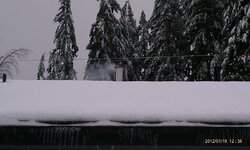About 9* outside as I left for work. House nice and comfortable - had a beautiful fire going for the day. Looked at the stack and saw a bit of steam blowing and icicles growing off the bottom of the cap - looked to be pretty clear ice from the road, will have to check out the color when they fall off to see how clean they really are.
Then driving to work I passed another burner often times is billowing smoke (his cap looks to be dripping with creosote about this time of the year). He too had ice on the cap, but it looked to be very dark brown, almost black and significantly more of it.
So ice on the cap must be fairly common in this cold weather - I wonder if it implies anything about what is going on inside my exterior SS pipe etc. Thoughts? Opinions?
Then driving to work I passed another burner often times is billowing smoke (his cap looks to be dripping with creosote about this time of the year). He too had ice on the cap, but it looked to be very dark brown, almost black and significantly more of it.
So ice on the cap must be fairly common in this cold weather - I wonder if it implies anything about what is going on inside my exterior SS pipe etc. Thoughts? Opinions?




